DOXERCALCIFEROL - INJECTION
PHONETIC PRONUNCIATION: (DOX-er-kal-SIF-er-ol)
COMMON BRAND NAME(S): Hectorol
GENERIC NAME(S): doxercalciferol
Uses
USES: This medication is used to treat people with serious kidney disease on dialysis who have high levels of a certain substance (parathyroid hormone-PTH), which your body normally makes. High PTH levels affect the balance of other minerals in your body (calcium and phosphorus) and may cause weak bones. Doxercalciferol is a form of vitamin D. It works by decreasing PTH levels and increasing calcium/phosphorus levels in the body.
How to use DOXERCALCIFEROL - INJECTION
HOW TO USE: This medication is given by injection into a vein as directed by your doctor, usually 3 times a week (such as Monday, Wednesday, Friday) at the end of dialysis. The dosage is based on your medical condition, laboratory tests, and response to treatment. Your doctor may adjust your dose or temporarily stop this drug based on laboratory test results (such as PTH, calcium, and phosphorus levels). If you are using this medication at home, learn all preparation and usage instructions from your health care professional and the product package. Before using, check this product visually for particles or discoloration. If either is present, do not use the liquid. Learn how to store and discard medical supplies safely. It is very important to follow the diet recommended by your doctor to get the most benefit from this medication and to prevent serious side effects. Do not take more than 2 grams of calcium a day while you are taking this medication. Sources of calcium include your diet, phosphate binders, or calcium supplements. If you have any questions about how much calcium you take in a day, ask your doctor or pharmacist. Do not take other supplements/vitamins (such as vitamin D) unless otherwise directed by your doctor. (See also Drug Interactions section.)
Side Effects
Precautions
Interactions
Overdose
Images
Reviews
Faq for DOXERCALCIFEROL - INJECTION
Doxercalciferol injection is a prescription medication used to treat a certain type of bone disease in patients with chronic kidney disease.
Doxercalciferol is a synthetic form of vitamin D that helps the body to properly absorb and utilize calcium and phosphorus. It helps regulate the levels of these minerals in the body, which is essential for healthy bones.
Doxercalciferol injection is primarily used to treat secondary hyperparathyroidism in patients with chronic kidney disease. It is also sometimes used to treat abnormally high levels of parathyroid hormone (PTH) caused by conditions like hypoparathyroidism or pseudohypoparathyroidism.
Doxercalciferol is given as an injection into a muscle (intramuscular injection) or a vein (intravenous injection). The route of administration will depend on the specific condition being treated and the healthcare provider's instructions.
Dosage of Doxercalciferol injection is highly individualized and prescribed by a healthcare professional based on factors such as the patient's age, weight, other medications being taken, and the severity of the condition being treated. It is important to follow the prescribed dosage and schedule exactly as directed.
Common side effects of Doxercalciferol injection include nausea, vomiting, loss of appetite, constipation, headache, dizziness, and dry mouth. Serious side effects may include high calcium levels, allergic reactions, and abnormal heart rhythm. It is important to contact a healthcare provider if any severe side effects occur.
Yes, Doxercalciferol injection can interact with certain medications, including medicines that lower cholesterol levels (statins), antacids, and certain seizure medications. It is important to inform the healthcare provider about all medications and supplements being taken to avoid potential interactions.
Doxercalciferol injection should not be used by individuals who have high levels of calcium or vitamin D, are allergic to ingredients in the medication, or have an abnormal sensitivity to vitamin D.
Doxercalciferol injection should be used during pregnancy or breastfeeding only if the potential benefits outweigh the potential risks. It is important to discuss the potential risks with a healthcare provider before using this medication.
Disclaimer
IMPORTANT: HOW TO USE THIS INFORMATION: This is a summary and does NOT have all possible information about this product. This information does not assure that this product is safe, effective, or appropriate for you. This information is not individual medical advice and does not substitute for the advice of your health care professional. Always ask your health care professional for complete information about this product and your specific health needs.

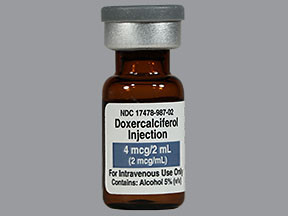
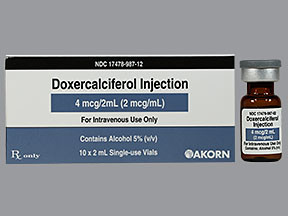
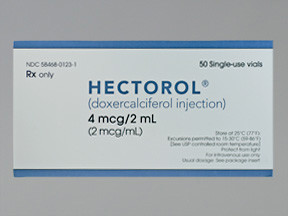
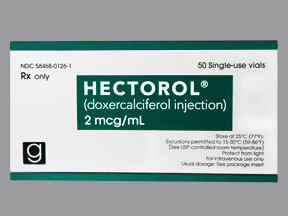
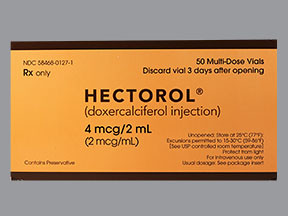

No Reviews Yet